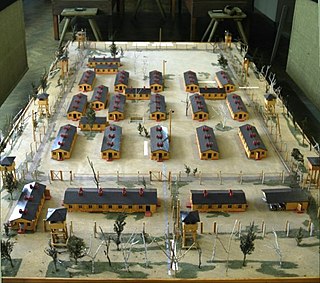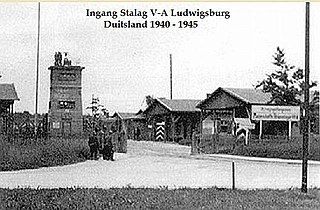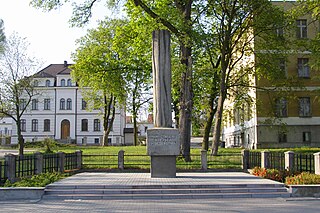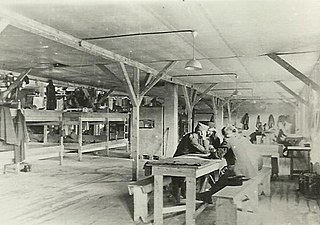
Stalag Luft III was a Luftwaffe-run prisoner-of-war (POW) camp during the Second World War, which held captured Western Allied air force personnel.

Stalag III-A was a German World War II prisoner-of-war camp at Luckenwalde, Brandenburg, 52 kilometres (32 mi) south of Berlin. It housed Polish, Dutch, Belgian, French, Yugoslav, Russian, Italian, American, Romanian, British and other Allied POWs.

Stalag XI-B and Stalag XI-D / 357 were two German World War II prisoner-of-war camps (Stammlager) located just to the east of the town of Fallingbostel in Lower Saxony, in north-western Germany. The camps housed Polish, French, Belgian, Soviet, Italian, British, Yugoslav, American, Canadian, New Zealander and other Allied POWs.

Stalag VIII-A was a German World War II prisoner-of-war camp, located just to the south of the town of Görlitz in Lower Silesia, east of the River Neisse. The location of the camp lies in today's Polish town of Zgorzelec, which lies over the river from Görlitz.

Stalag IV-B was one of the largest prisoner-of-war camps in Germany during World War II. Stalag is an abbreviation of the German Stammlager. It was located 8 km (5.0 mi) north-east of the town of Mühlberg in the Prussian Province of Saxony, just east of the Elbe river and about 30 mi (48 km) north of Dresden. From 1944 to 1945 it belonged to the Province of Halle-Merseburg. Now, the area is in Brandenburg. A sub-camp, sometimes identified as Stalag IV-B/Z,Stalag 304 or Stalag IV-H was located at Zeithain, 10 km (6.2 mi) to the south in Saxony.

Stalag VIII-C was a German World War II prisoner-of-war camp, near Sagan, Lower Silesia. It was adjacent to the famous Stalag Luft III, and was built at the beginning of World War II, occupying 48 ha. It housed Allied POWs of various nationalities, incl. Polish, French, Belgian, British, Canadian, Greek, Yugoslav, Soviet, Australian, New Zealand, South African, Italian, Senegalese, Algerian, Moroccan and Slovak.

Stalag VIII-F was a German prisoner-of-war camp for Soviet Red Army and Polish Home Army prisoners during World War II. It was located at the northern end of a Germany Army training area at Lamsdorf, Silesia, just to the north of Stalag VIII-B.

Stalag VII-A was the largest prisoner-of-war camp in Nazi Germany during World War II, located just north of the town of Moosburg in southern Bavaria. The camp covered an area of 35 hectares. It served also as a transit camp through which prisoners, including officers, were processed on their way to other camps. At some time during the war, prisoners from every nation fighting against Germany passed through it. At the time of its liberation on 29 April 1945, there were 76,248 prisoners in the main camp and 40,000 or more in Arbeitskommando working in factories, repairing railroads or on farms.
Stalag IX-C was a German prisoner-of-war camp for Allied soldiers in World War II. Although its headquarters were located near Bad Sulza, between Erfurt and Leipzig in Thuringia, its sub-camps – Arbeitskommando – were spread over a wide area, particularly those holding prisoners working in the potassium mines, south of Mühlhausen.
Stalag IV-A Elsterhorst was a World War II German Army prisoner-of-war camp located south of the village of Elsterhorst, near Hoyerswerda in Saxony, 44 kilometres (27 mi) north-east of Dresden.

Stalag V-A was a German World War II prisoner-of-war camp (Stammlager) located on the southern outskirts of Ludwigsburg, Germany. It housed Allied POWs of various nationalities, including Poles, Belgians, Dutchmen, Frenchmen, Britons, Soviets, Italians and Americans.

Stalag XVIII-A was a World War II German Army (Wehrmacht) prisoner-of-war camp located to the south of the town of Wolfsberg, in the southern Austrian state of Carinthia, then a part of Nazi Germany. A sub-camp Stalag XVIII-A/Z was later opened in Spittal an der Drau about 100 km (62 mi) to the west.
Stalag XIII-C was a German Army World War II prisoner-of-war camp (Stammlager) built on what had been the training camp at Hammelburg, Lower Franconia, Bavaria, Germany.

Oflag XXI-B and Stalag XXI-B were World War II German prisoner-of-war camps for officers and enlisted men, located at Szubin a few miles southwest of Bydgoszcz, Poland, which at that time was occupied by Nazi Germany.

During World War II, Nazi Germany engaged in a policy of deliberate maltreatment of Soviet prisoners of war (POWs), in contrast to their general treatment of British and American POWs. This policy, which amounted to deliberately starving and working to death Soviet POWs, the bulk of whom were Slavs, was grounded in Nazi racial theory, which depicted Slavs as sub-humans (Untermenschen). The policy resulted in some 3.3 to 3.5 million deaths.
Stalag Luft I was a German World War II prisoner-of-war (POW) camp near Barth, Western Pomerania, Germany, for captured Allied airmen. The presence of the prison camp is said to have shielded the town of Barth from Allied bombing. About 9,000 airmen – 7,588 American and 1,351 British and Canadian – were imprisoned there when it was liberated on the night of 30 April 1945 by Soviet troops.

Stalag I-A was a German prisoner-of-war camp during World War II, located in the village of Stabławki. It housed mainly Polish, Belgian, French and Russian prisoners of war, but also Britons and Italians.
Stalag I-F was a German World War II prisoner-of-war camp located just north of the city of Suwałki in German-occupied Poland.

Nazi Germany operated around 1,000 prisoner-of-war camps during World War II (1939-1945).














